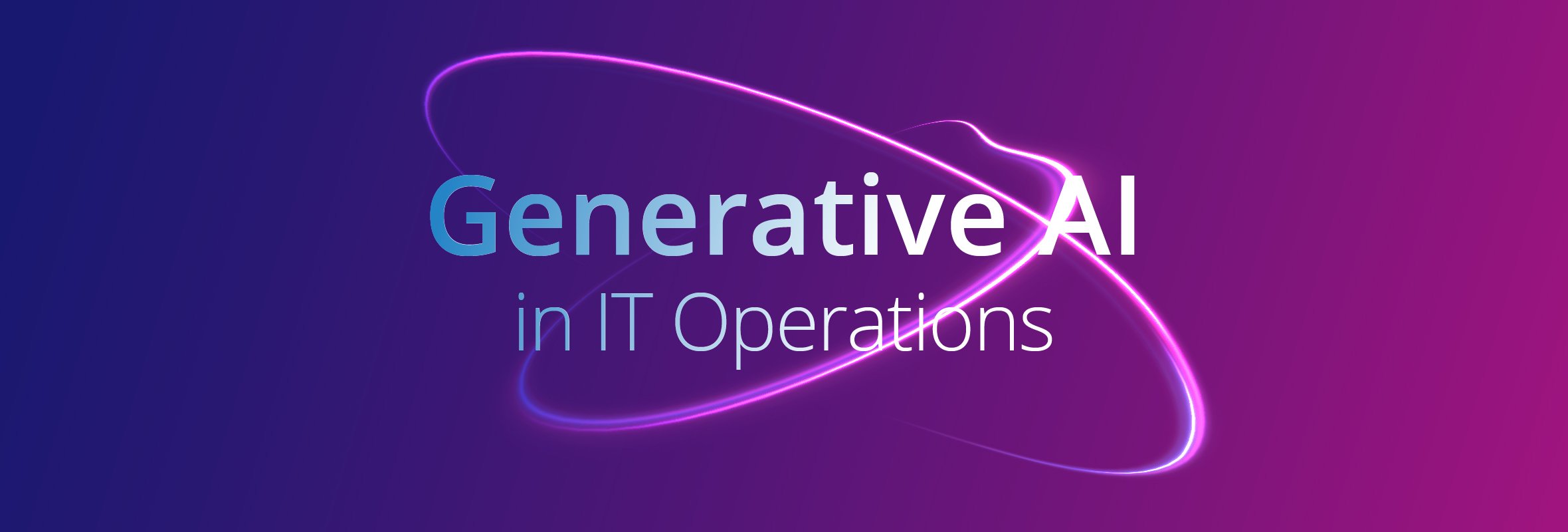Although Generative AI traces its origins to the earliest machine learning models in the 1950s, its popularity and usage has accelerated exponentially over the past year after OpenAI issued the first public release of its ChatGPT (generated pre-trained transformer) AI chatbot in December 2022. Generative AI holds the potential to transform many professions including IT operations. In this blog post, we'll explore how IT operations teams can leverage Generative AI to enhance productivity, streamline troubleshooting and routine processes, and drive more innovation.
- Automate Troubleshooting and Issue Resolution: Generative AI can be a game-changer for ITOps teams by automating troubleshooting and issue resolution processes. By analyzing historical data, identifying patterns, and learning from past incidents, Generative AI can predict and proactively address potential issues before they escalate into performance degradations or outright outages. This will help to not only reduce slowdowns and downtime but will also free up IT pros to focus on more strategic tasks and innovation.
- Improve Decision-Making with Predictive Analytics: Generative AI excels in predictive analytics, providing IT operations teams with insights into potential future challenges. By analyzing vast datasets, Generative AI can predict system failures, performance bottlenecks, and security threats. This enables ITOps teams to make more informed decisions, allocate resources more effectively, and preemptively address issues, thereby minimizing disruptions and downtime.
- Streamline Incident Response: Incident response is a critical and often time-consuming task of IT operations. Generative AI can streamline this process by providing real-time analysis of incidents, suggesting appropriate responses, and even automating certain routine actions. This not only accelerates incident resolution but also ensures consistency, thereby reducing the risk of human error.
- Optimize Resource Allocation: Generative AI can assist IT teams in optimizing resource allocation and capacity by analyzing usage patterns and predicting future demands. This helps to prevent both over-provisioning and under-provisioning of resources, ensuring that IT infrastructure is both efficient and cost-effective. Again, by automating resource allocation decisions, Generative AI frees up IT teams to focus more on strategic planning and innovation, rather than resource provisioning.
- Continuously Learn & Improve: Generative AI continuously learns and adapts to always-evolving IT landscapes and technologies. It can stay up to date on the latest industry trends, security threats, and technological advancements. By leveraging Generative AI, IT operations teams can keep their skills and knowledge base current, ensuring they remain at the forefront of the ever-changing IT landscape, fostering a culture of continuous improvement and innovation.
But where should you start and how? Here are a few practical tips and tricks for starting to effectively leverage Generative AI in your IT operations.
- Understand Your Data: Before diving into Generative AI, ensure that you have a deep understanding of your organization's data. Knowing the nuances of your data helps in training the AI model(s) you choose to use effectively. Consider the specific elements of your IT environment, the types of issues you commonly encounter, and all of your relevant data sources for optimal results.
- Start Small & Scale Gradually: Embarking on a Generative AI journey can be overwhelming. Begin with small, well-defined use cases to demonstrate value and quick wins. Whether it's automating routine tasks, predicting system failures, or optimizing resource allocation, starting small builds confidence and trust, allows for smoother integration and paves the way for a more scalable implementation and more complex use cases.
- Foster Collaboration: Generative AI is most effective when it complements, not replaces, human expertise. Foster collaboration between Generative AI systems and your IT pros. Encourage your teams to share insights, leverage the AI's recommendations, and collectively work towards common goals and objectives. This collaboration can lead to more accurate models and more innovative problem-solving.
- Prioritize Security & Compliance: Ensure that the AI model(s) you use adheres to industry standards and data protection regulations. Regularly assess the security measures in place to safeguard your sensitive information and to prevent any vulnerabilities in the AI system.
- Integrate with Existing Tools: Generative AI should seamlessly integrate with, not replace, your existing IT platforms and tools. Ensure compatibility with your existing IT management systems, monitoring tools, and communication channels. A well-integrated system enhances your team’s efficiency and minimizes disruptions to your existing workflows and processes.
- Regularly Monitor Performance: Track key performance indicators (KPIs) such as accuracy, response time, and the impact on operational efficiency. Periodically evaluate the AI model's effectiveness and be ready to make adjustments based on feedback and your evolving IT requirements.
- Continuously Train & Update: Generative AI models thrive on continuous learning. Regularly update and retrain your AI models with the latest data to ensure they remain current, relevant and effective. This proactive approach allows the model to adapt to new technologies, evolving IT landscapes, emerging threats, and changing operational dynamics. And encourage a culture of continuous learning within your IT operations team as well. A culture of learning fosters innovation and ensures that your team is well-equipped to leverage the full potential of Generative AI.
Generative AI has the potential to revolutionize IT operations, making processes more efficient, predictive, and innovative. By automating routine tasks, predicting issues before they arise, and providing valuable insights, Generative AI can empower and enable IT pros to focus on strategic initiatives and drive more innovation within their organizations. By following these tips and tricks, organizations can better navigate the implementation of Generative AI and unlock its full potential in helping to transform IT operations for the future.
Next Steps:
- Read the Blog: What Will 2024 Bring to the ITOps World? OpsRamp’s Technology Leaders Make Their Predictions
- Read the Blog: What’s the Difference Between AIOps and Observability?
- Check out all of the OpsRamp Blog’s coverage of AIOps
- Follow OpsRamp on Twitter and LinkedIn for real-time updates and news from the world of IT operations.






